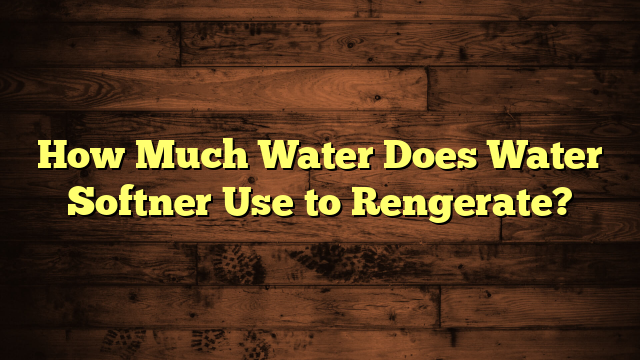How Much Water Does Water Softner Use to Rengerate?
When it comes to water softeners, you might wonder how much water they actually use during the regeneration process. Typically, these systems can consume anywhere from 30 to 100 gallons per cycle, depending on various factors like the hardness of your water and the size of the unit. If you're part of a larger household or live in an area with particularly hard water, you may find yourself facing higher water bills. But what if there are ways to minimize this usage without sacrificing efficiency? The answers might surprise you.
Key Takeaways
- Residential water softeners typically use 30-100 gallons per regeneration cycle, depending on the system type and efficiency.
- High-efficiency models may use as little as 20 gallons for regeneration, reducing overall water consumption.
- Salt-based systems generally require 40-100 gallons, while dual tank models use 20-50 gallons due to demand-initiated regeneration.
- Regeneration frequency varies with water hardness and household usage, impacting total water consumption.
- Efficient regeneration practices minimize water waste, contributing to lower utility bills and prolonged equipment lifespan.
Understanding Water Softener Regeneration
Understanding how a water softener regenerates is fundamental for managing its water usage effectively. The regeneration process is essential for maintaining the softener's efficiency. During this process, the softener cleans itself by flushing out the accumulated hardness minerals, like calcium and magnesium, from its resin beads.
When you initiate regeneration, a brine solution—made from salt and water—flows through the resin tank. This solution displaces the hardness minerals, allowing them to drain away.
It's important to note that the regeneration process typically occurs after a certain volume of water has been softened, ensuring that the system only regenerates when necessary.
You might wonder how often this process happens. That largely depends on your water usage and the hardness level of your water. By understanding the timing and frequency of regeneration, you can optimize your softener's efficiency and manage its water consumption.
A well-maintained water softener not only enhances your water quality but also minimizes waste, ensuring you get the most out of your investment.
Keeping an eye on these factors will help you enjoy soft water without unnecessary excess.
Typical Water Usage Rates
When it comes to the water usage of a water softener, it's helpful to know the typical rates associated with regeneration. Most residential water softeners use between 30 and 100 gallons of water each time they regenerate. This process typically occurs every few days, depending on your water hardness and daily usage.
In an efficiency comparison, newer models tend to be more water-efficient than older systems. For instance, high-efficiency softeners may use as little as 20 gallons for regeneration, making them a better choice if you're concerned about water conservation.
You might be wondering how your current system stacks up against these typical rates. If you've noticed your water bill increasing, it could be due, in part, to how much water your softener is using during regeneration.
By understanding these typical water usage rates, you can make informed decisions about whether it's time to upgrade your system.
Ultimately, knowing the average water usage can help you evaluate your water softener's efficiency and its impact on your overall water consumption. This knowledge empowers you to choose the best options for your household's needs.
Factors Affecting Water Consumption
Several factors can affect how much water your water softener uses during regeneration. One of the main factors is water hardness. If your water supply has a high hardness level, your softener needs to regenerate more frequently, which means it'll use more water.
You might find that your softener's performance varies based on the minerals present in your water, like calcium and magnesium.
Another important factor is your regeneration schedule. If you've set your softener to regenerate at shorter intervals, it'll consume more water overall. Conversely, a longer schedule may reduce water usage but can lead to less effective softening if it runs out of capacity.
Additionally, the size of your water softener plays a role; larger systems may require more water for regeneration but can service a bigger household, balancing overall efficiency.
Finally, your household water usage habits can influence how often your softener needs to regenerate. If you use a lot of water daily, your softener will work harder, leading to increased water consumption during regeneration.
Keeping these factors in mind helps you manage your water usage effectively.
Comparing Different Water Softeners
Choosing the right water softener can make a big difference in your home's water quality and efficiency. When comparing different options, you'll often come across salt-based systems and dual tank models. Each has its own advantages that suit various needs.
Here's a quick comparison to help you decide:
| Type | Water Usage (gallons) | Regeneration Method |
|---|---|---|
| Salt-Based Systems | 40-100 | Time-initiated |
| Dual Tank Models | 20-50 | Demand-initiated |
| Standard Systems | 60-120 | Time-initiated |
Salt-based systems are the most common and effective, but they can use more water during regeneration. On the other hand, dual tank models are designed to minimize downtime and water usage by regenerating one tank while the other is in service.
Think about your household's water needs, usage patterns, and budget. Your choice can notably impact both water quality and your monthly utility bills. By weighing these factors, you can select a water softener that best fits your lifestyle, ensuring you enjoy the benefits of soft water without excessive waste.
Regeneration Cycle Frequency
Understanding the regeneration cycle frequency of a water softener is crucial to optimizing its efficiency and minimizing water waste. The regeneration frequency directly impacts how often your softener cleans itself, using water and salt in the process.
Many systems allow you to adjust the softener settings to match your household's water usage, which can greatly influence the regeneration cycle. If you have a larger household or use more water, your softener will likely need to regenerate more frequently. Conversely, smaller households may benefit from less frequent cycles.
It's important to find a balance; regenerating too often wastes water and salt, while not regenerating enough can lead to hard water issues. To set the right regeneration frequency, consider your water hardness and daily consumption.
Most modern softeners come equipped with features that help you monitor and adjust these settings easily. By tailoring the regeneration cycle to your needs, you'll enhance your softener's performance, reduce waste, and enjoy softer water without unnecessary costs.
Keeping an eye on these settings guarantees that your system runs at peak efficiency, maximizing both water and salt usage.
Impact on Water Bills
When you think about installing a water softener, it's crucial to reflect on how it affects your water bills.
The regeneration process uses a certain amount of water, which can impact your overall costs, depending on the method you choose.
Regeneration Water Usage
Regeneration cycles in water softeners can considerably impact your water bills. When your system regenerates, it uses a specific amount of water, and this usage can vary based on your regeneration frequency. If you have hard water, your softener will regenerate more often, leading to increased water consumption.
While you might appreciate the improved water quality, it's important to recognize that frequent regeneration means more water flowing through your meter.
For instance, if your softener regenerates every few days instead of weekly, your total water usage will rise. Over time, those extra gallons add up, affecting your monthly bill.
To minimize this, consider adjusting your regeneration settings based on your actual water needs. Some systems allow you to customize the frequency based on usage patterns, which can help you strike a balance between soft water benefits and water conservation.
Ultimately, being mindful of your water softener's regeneration cycle can save you money. Regularly monitor your water quality and adjust settings as necessary.
Cost Implications Explained
Many homeowners don't realize the hidden costs associated with a water softener until they see the impact on their water bills. While you may benefit from softened water, the regeneration process consumes water, which can translate into higher costs.
To help you understand the financial implications, consider these three key points:
- Increased Water Usage: Each regeneration cycle uses a significant amount of water, which can add up over time. This can lead to noticeable spikes in your water bill each month.
- Electricity Costs: If your water softener is electric, it may also contribute to your energy expenses. Regeneration cycles require power, and that can affect your overall budget planning.
- Potential Cost Savings: On the flip side, softened water can prolong the life of your plumbing and appliances, leading to long-term cost savings. It can also reduce soap usage, which can further offset your expenses.
Being aware of these factors can help you make informed decisions and incorporate the costs into your budget planning.
Comparing Water Softening Methods
Water softening methods vary in their impact on your water bills, and understanding these differences can help you choose the best option for your home. Salt-based systems are the most common choice, but they can lead to higher water usage during regeneration cycles.
Efficiency comparisons show that while they effectively remove hardness, they mightn't be the best for your budget long-term.
On the other hand, alternative methods, such as salt-free softeners, typically require less water and may have lower maintenance requirements. However, performance metrics can vary based on the resin types used, which can affect customer satisfaction.
Cost analysis reveals that while initial installation processes may differ, the ongoing expenses often make a significant difference in your monthly bills.
Moreover, consider the environmental impact of each method. Salt-based systems can contribute to water pollution, while alternative methods tend to be more eco-friendly.
Tips for Reducing Water Usage
Reducing water usage in your home can greatly enhance both your sustainability efforts and your budget.
Implementing effective water conservation techniques helps you save money while contributing to a healthier planet. Here are three efficiency strategies you can easily adopt:
- Install Low-Flow Fixtures: Replace standard faucets, showerheads, and toilets with low-flow alternatives. These fixtures can considerably reduce your water consumption without sacrificing performance.
- Practice Mindful Watering: If you have a garden, water it in the early morning or late evening to minimize evaporation. Furthermore, consider using drip irrigation systems, which deliver water directly to the roots.
- Monitor Your Usage: Keep an eye on your water bill and usage patterns. Identifying spikes can help you pinpoint leaks or wasteful habits, allowing you to take corrective action.
Benefits of Efficient Regeneration
When your water softener regenerates efficiently, you'll notice several key benefits that make a real difference.
Reduced water waste means you're conserving more, which translates to lower utility bills and a happier wallet.
Plus, efficient regeneration can extend the lifespan of your equipment, saving you from costly replacements down the line.
Reduced Water Waste
Efficient regeneration of water softeners not only enhances performance but also minimizes water waste, making it a smart choice for eco-conscious homeowners.
By opting for efficient systems, you contribute to water conservation, reducing the overall strain on our valuable water resources.
Here are three key benefits of using water softeners with efficient regeneration:
- Less Water Used: Advanced systems regenerate using considerably less water than traditional models, allowing you to save on both water and your environmental footprint.
- Improved Performance: Efficient regeneration means your water softener will work effectively, ensuring you consistently enjoy soft water without the frequent need for maintenance.
- Sustainability: By reducing water waste, you're not just benefiting your household; you're also playing a part in the larger effort to conserve water for future generations.
Choosing a water softener that emphasizes efficient regeneration aligns with your commitment to sustainability.
It's a practical step you can take that reflects both personal responsibility and environmental awareness.
Lower Utility Bills
Investing in a water softener with efficient regeneration can lead to significant savings on your utility bills. By using less water during the regeneration process, you're not just conserving water; you're also cutting down on costs associated with water usage.
When your water softener operates efficiently, it minimizes the amount of water needed to rinse and recharge the resin beads, meaning you spend less on both your water and wastewater bills.
Moreover, efficient regeneration often translates into lower energy consumption. Many modern water softeners are designed to use less electricity and water, which directly impacts your monthly utility expenses.
As you embrace water conservation, you'll notice that these savings can add up over time.
In addition to reducing your bills, an efficient water softener helps maintain ideal water quality. Softened water improves the effectiveness of soaps and detergents, so you might find yourself needing less cleaning product, further enhancing your utility savings.
Extended Equipment Lifespan
How can efficient regeneration enhance the lifespan of your equipment? When your water softener regenerates effectively, it not only improves water quality but also prolongs the equipment lifespan. By minimizing wear and tear, you'll find that your appliances and plumbing systems last longer, saving you money in the long run.
Here are three key benefits of efficient regeneration:
- Reduced Scale Buildup: Properly softened water means fewer mineral deposits in your pipes and appliances, which can lead to clogs and malfunctions.
- Lower Maintenance Costs: By adopting effective maintenance practices, you decrease the frequency of repairs and replacements, allowing your equipment to operate smoothly for years.
- Improved Energy Efficiency: Well-maintained equipment runs more efficiently, leading to lower energy bills and a smaller carbon footprint.
Incorporating efficient regeneration into your routine not only protects your investment but also guarantees that your home runs smoothly.
By being proactive, you're not just extending the equipment lifespan; you're creating a more reliable and cost-effective home environment.
Frequently Asked Questions
How Long Does the Regeneration Process Take?
The regeneration process typically takes about 30 to 60 minutes, depending on your system. You'll notice this happens every few days, so plan accordingly to minimize disruptions during the regeneration duration.
Can Water Softeners Use Salt Alternatives?
Yes, you can use salt substitutes in water softeners. Eco-friendly options like potassium chloride are available, providing an effective solution without the environmental impact of traditional salt. Just verify your system's compatible with these alternatives.
Do Water Softeners Waste Water During Regeneration?
Isn't it ironic? You're saving water with a softener, yet it does waste some during regeneration. However, modern systems have improved regeneration efficiency, minimizing water waste while keeping your water soft and enjoyable.
Is Water Softener Regeneration Affected by Water Temperature?
Yes, water temperature affects regeneration efficiency. Warmer water enhances the process, allowing the resin to regenerate more effectively. If you're using cold water, you might notice less efficient softening and longer regeneration times.
What Happens if Regeneration Is Skipped?
Skipping regeneration's like ignoring a clock's chime; you risk buildup and inefficiency. The regeneration effects diminish, leading to hard water issues and potential damage. Don't let skipped maintenance turn your water softener into a ticking time bomb.
Conclusion
To sum up, understanding how much water your softener uses during regeneration can help you make informed decisions about your water usage. While typical models consume between 30 to 100 gallons, high-efficiency options can save you significant amounts. By considering factors like household size and water hardness, you can choose a system that fits your needs. Ultimately, being mindful of your water softener's performance not only conserves water but also keeps your bills in check, making it a smart choice for any home.







